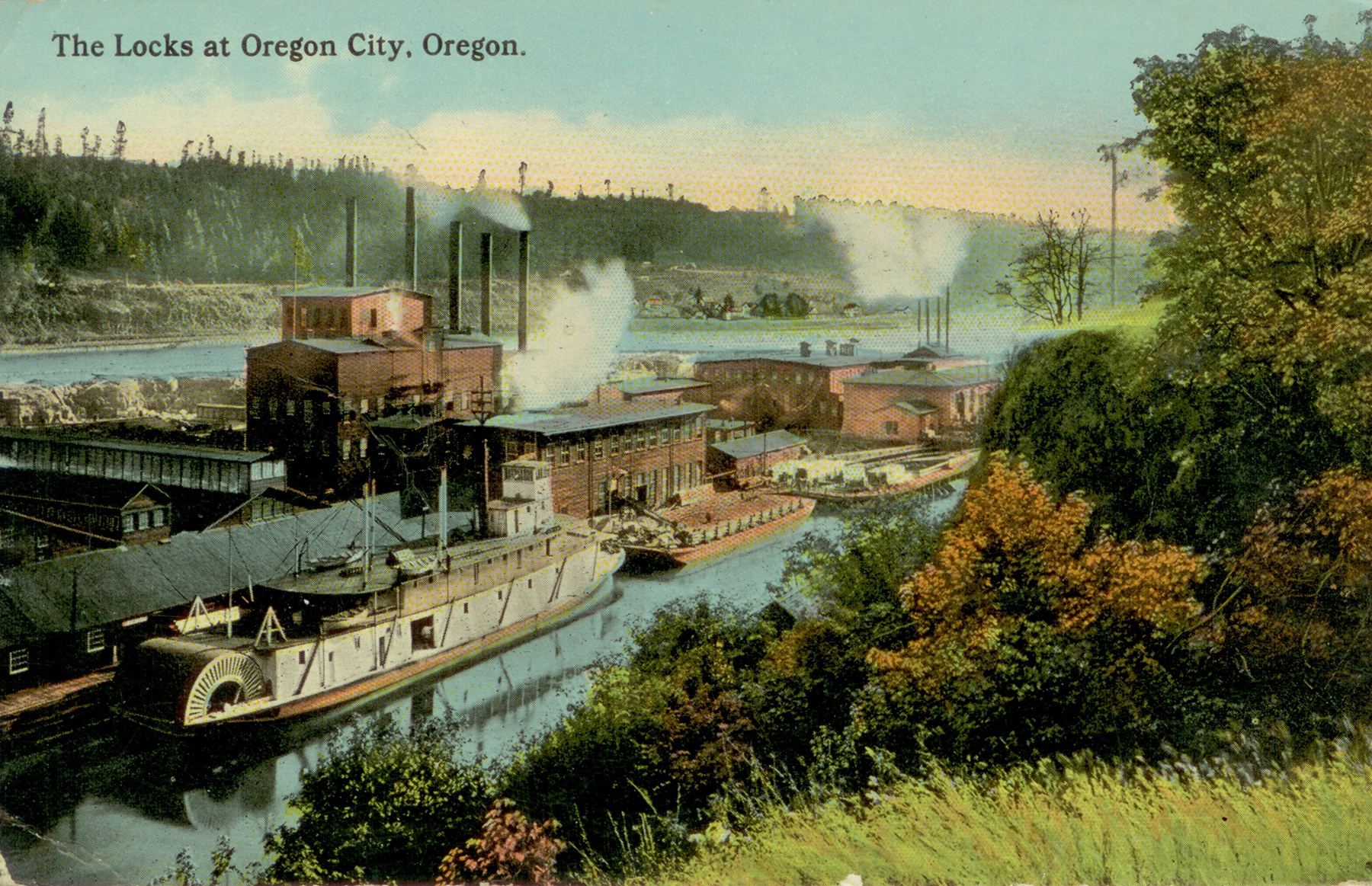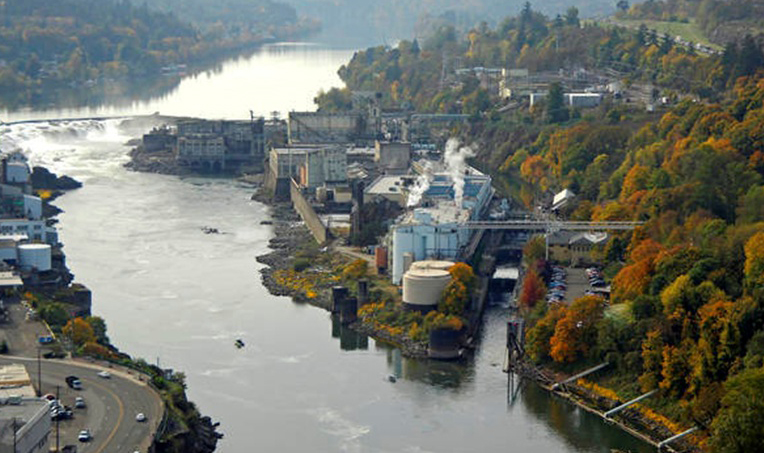 Wikipedia Commons
Wikipedia CommonsCompleted in 1873, the Willamette Falls Locks in Oregon were the first significant facilities built to improve navigation on the Columbia-Snake River Inland Waterway, one of America’s few national inland waterways.
The locks are a rare surviving example of this type of canal and lock construction and were placed on the National Register of Historic Places in 1974. In 1991, ASCE’s Oregon Section also designated the locks as an Oregon Historic Civil Engineering Landmark.
Further reading:
- Benefits flow quickly as historic dam removal restores Klamath River
- California’s subway tunnels exemplify seismically safe infrastructure
- Oregon gains power-efficient, seismically robust airport terminal
Owned and operated by the U.S. Army Corps of Engineers since 1915, the system consists of a canal and five navigational locks that bypass Willamette Falls, the waterfalls on the Willamette River between Oregon City and West Linn, Oregon. The locks are adjacent to a paper mill owned by the Willamette Falls Paper Co. and a hydroelectric power plant owned by Portland General Electric.
Over time, the locks and canal gradually deteriorated and fell out of use, with the canal walls leaking heavily and the use of the locks sinking from 2.2 million tons of commerce per year in 1943 to less than 1,000 tons per year in 1999. Although certain repairs were attempted in the 1980s, by 2005 the Corps placed the locks into “caretaker status,” which meant no preventive maintenance would be performed. In November 2011, the Corps shut down the locks entirely because of significant safety concerns related to the corrosion of the lock gate anchors.
In 2021, Oregon established a new public corporation called the Willamette Falls Locks Authority, which is preparing to take over the system. But before the locks can be transferred, the Corps has determined that seismic upgrades were needed.
Willamette Falls sit at the bottom of a steep walled canyon. The canal itself occupies a 100-foot-wide right-of-way across a narrow rock shelf consisting of a series of flat-lying basalt layers. The canal was cut and blasted through this basaltic rock. The lock walls are a combination of ashlar masonry cut from basalt in local quarries and timber facing and struts tied back with anchors to the underlying basalt bedrock.
The total length of the locks and canal is 2,300 feet.
Previous stability analyses performed on the masonry wall sections and gate monoliths indicated that most of the walls were unstable for both overturning and sliding under seismic loading. And while the ashlar masonry appeared in good condition, this construction method does not perform well under seismic load cases because the wall is unreinforced and any mortar still remaining between adjacent blocks is assumed to be of low strength. Moreover, critical loads would likely occur for the ashlar masonry when the chamber is full of water under a seismic event, which would produce the maximum uplift condition and horizontal loads that would reduce global stability of the walls.
Risk-informed design
The recently completed seismic and safety upgrades focused on a retrofit of a key concrete wall between the canal and the power plant forebay (the upstream water intake for the turbines), the masonry guard lock wall, and the masonry monoliths for gates 6 and 7, all on the riverward side. The overall purpose of the retrofit was to reduce the risk of failure to the damming surface during a seismic event.
A semiquantitative risk assessment of the locks was completed in 2020 as part of the Corps’ dam safety inspection program. The results of the assessment were in part repurposed for the risk-informed design of the seismic upgrade.
 Seamagazine
SeamagazineA probabilistic seismic hazard analysis indicated the primary sources of the hazard involved the Cascadia Subduction Zone fault-line interface and potential crustal earthquakes. A deterministic analysis of these earthquake sources evaluated the maximum design earthquake.
Because of the low potential for life loss at the locks site, a 950-year return period ground motions served as the maximum design earthquake. The design earthquakes also included the operating basis earthquake with a 144-year return period.
Seismic upgrades
The plan for seismic stabilization included using posttensioned, tiedown rock anchors to improve sliding and overturning stabilities under the operating basis earthquake and maximum design earthquake seismic loadings. The plan also considered sliding, overturning, floatation, and foundation bearing pressures under the usual and unusual loading combinations, including maximum water-level differentials.
The primary geological/geotechnical information for the site dated to the early 1940s but was supplemented by using average properties developed by the Corps for the design of the John Day Lock and Dam, on the Columbia River upstream of the confluence with the Willamette River. Those values were reviewed by a geologist to determine a subset of lava flows that best matches the Willamette Falls Locks location.
In addition, rock bolt anchorage field-testing from the Dalles Lock and Dam, also on the Columbia River, was used as a guide for the expected value of geotechnical parameters. These preliminary geotechnical properties were checked from May to June 2023 using a geotechnical investigation program developed by the Corps.
The outsides of the masonry guard lock wall and gate monoliths were constructed of hard basalt stone cut and fitted tightly together, forming a mortared stacked stone wall. Some of the mortar was observed to have weathered and washed away during the period of over 100 years since these structures were constructed.
Internal construction technique could not be verified without drilling into the wall or conducting destructive testing by excavating into the wall, none of which was practical prior to construction. Because of this, it was not clear if the wall interior was constructed of fitted mortared masonry blocks similar to what is exposed on the outside or filled with random rock and mortar backfill. Both types of interior construction have been used around the world.
The geotechnical investigation program included an optical televiewer survey of a core hole drilled into the masonry guard lock wall, which revealed that the guard lock wall consisted mostly of courses of stacked cut stones. There was, however, a zone in the wall interior that appeared to be a concrete-like fill consisting of cobble-sized rock fragments in a matrix of mortar. Core holes were not drilled into the gate monoliths, so the interior structure there remained unknown.
Anchoring away
A total of 71 tiedown rock anchors were installed from September 2023 to February 2024. At the concrete canal wall separating the canal from the power plant forebay, a total of 39 anchors were installed along an approximately 233-foot-long section, with an average spacing of about 5.7 feet on centers.
Anchor lengths varied from 56.5 feet to 90.5 feet, measured from the top of the wall to the bottom of the tendon bond length. These rock anchors were installed by removing short, preexisting concrete bar anchors, typically about 8 feet in length – which Portland General Electric had installed as part of deck improvements in 2015 – to secure the 3-foot-long concrete cap to the main body of the wall.
After these preexisting anchors were removed, the new tiedown rock anchors were installed at the same location by continuing the drilling through the concrete wall and into the underlying basalt bedrock.
At the masonry guard lock wall and monoliths, a total of 32 anchors were installed in the 251-foot-long section, with an average spacing of about 7.7 feet on center. At the masonry guard lock wall, a total of 29 reinforced-concrete pilasters were constructed on the forebay side of the wall. The tiedown anchors were installed through the pilasters and masonry and into the underlying foundation basalt bedrock, in which the bond zone was established.
These anchors were 55.5 feet long, measured from the top of the pilasters to the bottom of the tendon bond length. At the gate 6 monolith, one anchor was constructed directly into the ashlar masonry structure without a pilaster. At the gate 7 monolith, two anchors were constructed similarly without the use of pilasters.
The prime contractor, Northbank Civil and Marine, based in Vancouver, Washington, performed all concrete and ancillary work. A subcontractor, Jensen Drilling Co., based in Eugene, Oregon, designed the anchor details and elected to use seven-strand anchors with a 15-foot tendon bond length in the underlying basalt bedrock. Jensen performed installation, water pressure testing, and load testing of all the anchors.
For the anchors at the concrete canal wall, drilling was performed by 6- or 8-inch-diameter coring, to core over and remove preexisting concrete anchors, followed by 6-inch-diameter down-hole hammer percussion drilling.
The anchors at the masonry guard lock wall featured 6-inch-diameter coring through the pilasters and ashlar masonry, followed by 6-inch-diameter down-hole hammer percussion drilling in the basalt bedrock.
All anchors had a design load of 230 kips. They were tested to a maximum load of 285 kips and locked off at 270 kips. Jensen conducted performance testing on three anchors in the concrete canal wall and one anchor in the masonry guard lock wall. The remaining anchors were all proof-tested.
Access to the construction site started at a controlled entry point, through the operating paper mill onto the deck of the power plant forebay. Portland General Electric was also demolishing old mill buildings adjacent to the guard lock wall. Close coordination with the power plant and the paper company was maintained throughout construction.
A geotechnical investigation program consisting of exploratory borings, televiewer surveys, and laboratory testing was completed from May to June 2023. The Corps developed the geotechnical investigation program; a subcontractor, PLI Systems Inc., based in Hillsboro, Oregon, performed the exploratory drilling; a subconsultant, Carlson Geotechnical, based in Tigard, Oregon, performed the borehole logging, laboratory tests, and optical televiewer surveys. Rock anchors were installed and tested by Jensen from August 2023 to February 2024.
Although Northbank Civil and Marine had two years to complete the $4.3 million construction work, it finished in early April 2024 and fully demobilized from the site in June 2024.
The Corps attempted to equalize the water surface elevations inside the guard lock and the canal with the power plant forebay to minimize loss of circulation and grout during drilling and anchor installations, respectively. The forebay was drained during the in-water work period, which lasted from Oct. 15 to Dec. 31, 2023, to allow construction of the concrete pilasters in the dry on the forebay side of the masonry guard lock wall.
The tiedown rock anchors were installed from the power plant’s decking, with parts of the decking removed to allow access to the top of the concrete canal wall and the newly constructed pilasters. The removed decking was replaced after the anchor installation.
During installation of the anchors at the downstream end of the canal wall, major voids were discovered in the old concrete – remnants from earlier repair attempts to stop leakage. In these anchor holes, the contractor installed 6-inch-diameter steel casings at depths of 10-40 feet, which extended through the concrete and voids, and into bedrock to prevent grout loss during anchor installation. These casings extended about 15 feet into bedrock from the base of the concrete canal wall.
The Corps plans to transfer ownership of the locks to the Willamette Falls Locks Authority in 2026. The expected yearly benefits are expected to reach as much as $49 million in commercial transportation and up to $50 million in recreation.
At this location there is a confluence of river, road, and rail transportation systems, which means the retrofitted locks will promote competition and efficiency. The seismic upgrade just completed by the Corps will add resiliency to transportation in the region and help preserve this historic project.
Willamette Falls Locks seismic project plan view






